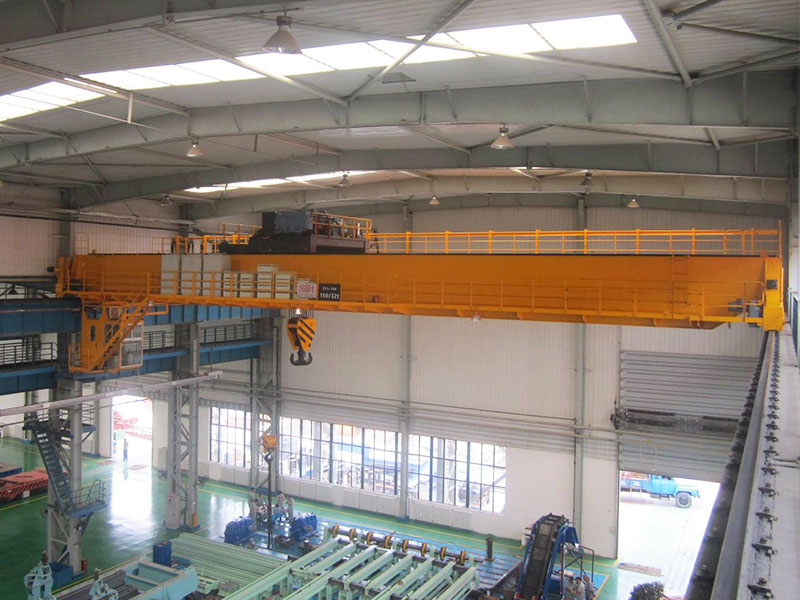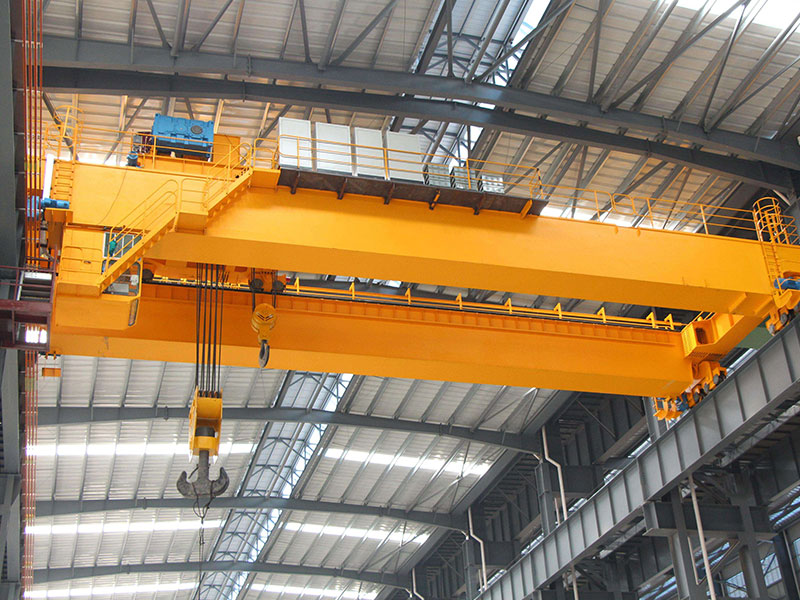In today’s fast-paced industrial environment, efficiency, safety, and reliability are paramount. Heavy-duty lifting equipment, such as 100-ton bridge cranes, plays a critical role in manufacturing plants, steel mills, warehouses, and construction sites. The high load capacity and continuous operation of these cranes mean that unplanned downtime can lead to significant production losses, safety hazards, and increased maintenance costs. To address these challenges, predictive maintenance (PdM) strategies using the Internet of Things (IoT) and sensor technologies have emerged as game-changing solutions for ensuring the optimal performance and longevity of 100-ton bridge cranes.

Understanding Predictive Maintenance
Predictive maintenance is a proactive maintenance approach that leverages real-time data and advanced analytics to anticipate equipment failures before they occur. Unlike reactive maintenance, which involves fixing equipment after a breakdown, or preventive maintenance, which schedules maintenance at fixed intervals regardless of actual equipment condition, predictive maintenance relies on condition monitoring. This enables maintenance teams to intervene only when necessary, minimizing downtime, extending the life of equipment, and optimizing maintenance costs.
For 100 ton bridge cranes, predictive maintenance is particularly valuable because these cranes handle extremely heavy loads and are subjected to mechanical, electrical, and structural stresses. Any failure in components such as the hoist, trolley, bridge, or runway can have severe operational and safety consequences.
Role of IoT in Predictive Maintenance
The Internet of Things (IoT) refers to a network of connected devices that collect, transmit, and analyze data. In the context of 100-ton bridge cranes, IoT devices can monitor crane components, operational parameters, and environmental conditions in real time. The data collected from these devices can then be analyzed using machine learning algorithms, cloud computing, and edge analytics to predict potential failures and recommend maintenance actions.
Key advantages of IoT in crane predictive maintenance include:
-
Real-time Monitoring: IoT sensors continuously capture the operational status of crane components, including motor vibrations, temperature, load weight, and structural stress.
-
Data-Driven Insights: Advanced analytics identify patterns, anomalies, and trends that indicate early signs of wear or failure.
-
Remote Monitoring: IoT enables maintenance teams and plant managers to monitor crane performance from anywhere, reducing the need for constant on-site inspection.
-
Reduced Downtime: By predicting failures before they occur, IoT-based predictive maintenance allows for scheduled interventions, minimizing unscheduled downtime and improving overall productivity.

Sensors for 100-Ton Bridge Cranes
A variety of sensors can be installed on 100-ton bridge cranes to enable predictive maintenance. These sensors track different parameters, providing a comprehensive view of the crane’s health. Some of the most commonly used sensors include:
1. Vibration Sensors
Vibration sensors detect irregularities in the movement of eot crane components, such as motors, gearboxes, and hoists. Excessive vibration often indicates wear, imbalance, misalignment, or impending mechanical failure. By monitoring vibration patterns, predictive maintenance systems can alert maintenance personnel to inspect and service affected components before they fail.
2. Temperature Sensors
Temperature sensors monitor the heat levels in critical crane components, including electric motors, bearings, and brakes. Overheating can signal excessive friction, lubrication failure, or electrical issues. Early detection of abnormal temperature rise allows maintenance teams to take corrective action, preventing catastrophic failures and extending component life.
3. Load Sensors
Load sensors measure the weight of lifted materials and monitor load distribution. Overloading or uneven load distribution can put excessive stress on the crane structure, hoist, and trolley, leading to premature wear or structural damage. By tracking load data, predictive maintenance systems can ensure safe operation and prevent overload-related failures.
4. Position and Motion Sensors
Position and motion sensors track the movement of the crane along the runway and bridge. They help detect issues such as misalignment, uneven motion, or obstructions. These sensors are particularly useful in preventing structural damage and ensuring smooth crane operation.
5. Lubrication and Wear Sensors
Lubrication and wear sensors monitor the condition of critical components such as wire ropes, gears, and bearings. These sensors detect insufficient lubrication, corrosion, or abnormal wear, signaling when maintenance or part replacement is required.
Implementing Predictive Maintenance
Implementing a predictive maintenance program for 100-ton bridge cranes involves several key steps:
1. Assessment and Planning
The first step is to evaluate the bridge crane existing maintenance practices, operating conditions, and critical components. Maintenance managers must identify which components are most prone to failure and determine the types of sensors and IoT devices required for effective monitoring.
2. Sensor Installation
Sensors are strategically installed on the crane’s hoist, trolley, bridge, motors, brakes, and other critical components. Proper placement ensures accurate and reliable data collection. Wireless sensors can reduce installation complexity, while wired sensors provide higher data fidelity in some cases.
3. Data Collection and Integration
Once installed, sensors continuously collect operational data, which is transmitted to a central monitoring system via IoT networks. This system integrates data from multiple cranes, providing a comprehensive overview of the equipment fleet. Data can be stored locally, in the cloud, or processed at the edge for real-time decision-making.
4. Data Analysis and Predictive Algorithms
Advanced analytics, machine learning models, and predictive algorithms process the collected data to identify trends, anomalies, and potential failure modes. For example, a sudden increase in vibration levels combined with rising motor temperature may indicate bearing failure in the hoist motor.
5. Maintenance Scheduling
Based on predictive insights, maintenance teams can schedule targeted interventions such as lubrication, part replacement, or mechanical adjustment. This reduces unnecessary maintenance tasks and ensures that critical components are serviced before failure occurs.
6. Continuous Improvement
Predictive maintenance is an ongoing process. Continuous monitoring and data analysis allow maintenance strategies to be refined over time, improving the accuracy of failure predictions and optimizing maintenance schedules.
Benefits of Predictive Maintenance for 100-Ton Bridge Cranes
Implementing IoT-enabled predictive maintenance offers numerous benefits for industrial operations:
-
Enhanced Safety: Early detection of potential failures reduces the risk of accidents and injuries caused by crane malfunction.
-
Increased Equipment Lifespan: Timely maintenance prevents excessive wear and damage, extending the service life of expensive crane components.
-
Reduced Downtime: Proactive interventions minimize unplanned downtime, ensuring uninterrupted production.
-
Lower Maintenance Costs: Maintenance activities are performed only when necessary, reducing labor, spare parts, and energy costs.
-
Improved Operational Efficiency: Real-time monitoring and predictive insights optimize heavy industrial bridge crane performance, enabling smoother and more reliable operations.
Challenges and Considerations
While IoT-based predictive maintenance offers significant advantages, there are challenges to consider:
-
Initial Investment: Installing sensors and IoT infrastructure can involve a substantial upfront cost. However, the long-term savings often outweigh the initial expense.
-
Data Security: IoT systems must be secured against cyber threats to protect sensitive operational data.
-
Technical Expertise: Effective implementation requires skilled personnel to install sensors, manage data analytics, and interpret predictive insights.
-
Integration with Existing Systems: Predictive maintenance solutions must be compatible with existing crane control and maintenance systems.
Conclusion
Predictive maintenance using IoT and sensors represents a transformative approach to managing 100-ton bridge cranes. By continuously monitoring critical components, analyzing real-time data, and predicting potential failures, industries can achieve safer, more reliable, and cost-effective crane operations. The integration of vibration sensors, temperature sensors, load sensors, and other IoT devices provides actionable insights that enable maintenance teams to act proactively rather than reactively.
As industrial operations grow increasingly complex and demanding, the adoption of predictive maintenance technologies is not just a competitive advantage – it is becoming a necessity. Companies that leverage IoT-enabled predictive maintenance for their 100-ton bridge cranes will benefit from enhanced safety, minimized downtime, extended equipment lifespan, and optimized operational efficiency. Ultimately, predictive maintenance ensures that these heavy-duty cranes continue to perform at peak performance, supporting the critical lifting and handling needs of modern industry.